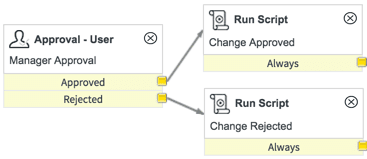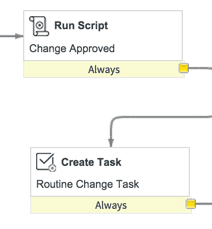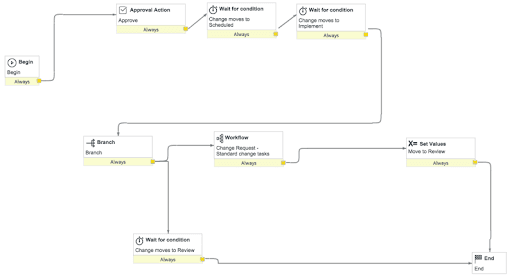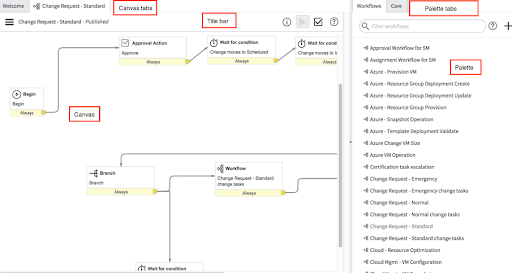- Home
- Blog
- ServiceNow
- What is Servicenow Workflow

- ServiceNow Interview Questions and Answers
- What is ServiceNow Ticketing Tool
- ServiceNow Tutorial
- Top 10 IT Management Tools
- ServiceNow Admin Interview Questions and Answers
- What is ServiceNow - A Complete Guide for Beginners
- What is ServiceNow GRC
- ServiceNow Reporting
- ServiceNow Data Model
- What is ServiceNow Orchestration
- What is ServiceNow ITIL - A Complete Overview
- ServiceNow vs Jira Service Management
- ServiceNow Architecture
- SLA ServiceNow
- ServiceNow Webassessor
- ServiceNow Integration With Jira
- ServiceNow Scripting Interview Questions
Many IT companies start their ServiceNow journey by replacing outdated, old service desk solutions and spending on a solution that can handle everything from the incidents to the assets. Rightfully, therefore, ServiceNow is the best ITSM(IT Service Management) solution in the market. The streamlined, ITIL(Information Technology Infrastructure Library) - based ITSM application of ServiceNow helps us minimize the time required to resolve an incident from start to end. ServiceNow provides an out-of-box Workflow editor and engine to automate and implement incident resolution and service desk operations. ServiceNow workflow automates the processes and activities in the applications. ServiceNow workflow is a big take for the automation on the ServiceNow platform. So, it is the fundamental block of ServiceNow. If you are planning for a ServiceNow career, then you must learn Workflow.
Through this blog, we will help you learn everything you need to know about Servicenow Workflow. Before we go ahead, let us look at what we will be discussing in this blog.
| What is Servicenow Workflow - Table Of Content |
What is a ServiceNow Workflow?
Workflow is a series of activities we use for automating the processes in the activities. The baseline Team development code review workflow emphasises the workflow anatomy. Activities are the workflow blocks that carry out various tasks like sending emails, obtaining approvals, running scripts, and configuring field values on the records.
Every workflow starts with a Begin activity and ends with the End activity. When the activity ends, the activity is available through the suitable node and transition is comprehended to the later activity.
Following are the ways to launch Workflows:
- UI Action
- Server-side script
- Triggered by field values on a record
| Do you want to build your career in ServiceNow, then Visit Mindmajix - a global online training platform: "ServiceNow Online Course" This course will help you to achieve excellence in this domain |
When to use Workflows
We use the workflows for automating the multi-step processes like:
- SLAs
- Approvals
- Event generation
- Task creation
- Email notifications
We can perform activities like event generation, email notification, task creation through other strategies. Using a workflow does not rely on the target: does the target need to process automation or discrete action. For instance, if the email has to be sent when we insert a new record in the database, the discrete action does not need a workflow.
Advantages of ServiceNow Workflow
ServiceNow Workflow advantages are:
- ServiceNow workflow automates IT operations and streamlines them with common updates.
- Workflow helps to enhance the employee’s productivity through its recent advancements.
- Workflow can change the work environment for both management and employees.
- Workflow reduces human errors by generating accurate results.
| Related article - Servicenow Interview Questions for Beginners |
Getting Started with ServiceNow Workflow
Workflow editor provides a drag-and-drop interface to automate multi-level processes throughout the platform. Following are the elements of a Workflow:
#1 Properties: Properties define configuration settings like workflow name, the table whose records the workflow deals with.
#2 Activities: Activities define the series of operations the workflow conducts like creating records, alerting users of running scripts, or pending approvals.
#3 Exit conditions: Exit conditions define the conditions under which we execute an activity.

#4 Transitions: Transitions define the conditions under which we execute a transition.

#5 Versions: Versions store historical design data about a workflow in the workflow version record.
#6 Contexts: Contexts store historical runtime data about a workflow run in the workflow context record.
| Visit here to learn ServiceNow Certification Course in Hyderabad |
Workflow Life cycle
A Workflow begins when a triggering event takes place. General triggers include inserting a record into a table or setting a field in a table to a particular value. For instance, we may create a workflow that executes whenever users request an item they need to order from the catalog. We can set up the workflows to run periodically or invoke them from scripts like business rules.
When an activity ends, the workflow transits to the subsequent activity. An activity can have various feasible transitions to many activities, depending on the activity outcome. If the user’s request is approved, the activity may transits that alerts us to order the item. When the user’s request is denied, the activity may transit to alert the user that the request has been denied.
[Also, read ServiceNow Developer Instance]
The Workflow editor illustrates workflows visually as a kind of flowchart. It displays activities as boxes tagged with the information about the transitions from one activity to the next activity as the lines linking the boxes.
Workflow Activities
Approval and Rollback Activities
- Approval Action: We use approval activities to approve the current task and label the task as approved or rejected.
- Approval Group: We use the Approval group for creating approval requests for every member of a particular group.
- Approval - User: We use it for creating multiple individual user approval requests.
- Rollback To: When we trigger this activity, it shifts the backward processing to a particular workflow activity and rollbacks the activities to their native state.
Conditional Activities
If: We use this activity for checking a condition or a script to evaluate whether yes or no.
- Switch workflow activity: We use Switch activity to check whether the passed variable or field value is equivalent to case values.
- Wait for condition workflow activity: Wait for condition activity makes the Workflow waits at this activity till the present record equals a particular condition.
- Wait for Workflow Event: This activity makes the workflow wait till a particular event is launched.
Notification Activities
- Create Event: We use the create event activity for adding an event to the event queue.
- Notification: We use this activity for sending an SMS message or Email to appropriate groups or users.
| Leave an Inquiry to learn ServiceNow Course in Bangalore |
Task Activities
- Attachment Note: It adds an attachment to the current record.
- Create Task: This activity creates a task.
- Catalog Task: The Catalog task activity selects the available fields on a form using a slush bucket or writing queries from the script.
Timer workflow activities
SLA Percentage Timer
This activity pauses the workflow for the time equal to an SLA percentage.
Timer: It pauses the workflow for a time period.
How to Create a Workflow
Procedure to create a Workflow:
- Step1: Go to “Workflow/Workflow Editor”
- The Workflow editor opens with the Welcome page.
- Step2: In the Workflows tab of the Palette, press “New Workflow”.
- Step3: Fill out the “Table” and “Name” fields.
- Step4: Add a Description.
- Step5: Press “Submit”.
- Step7: By adding the activities, validating, and publishing workflows, we complete creating the workflow.
- Step7: For changing the advanced settings of the workflow, press the “Properties” icon.
Sample Workflow:

After we create or open a new workflow, the system shows the Workflow canvas. We communicate with the Workflow editor in the workflow canvas using different elements like canvas tabs, palette, title bar, and palette tabs.
Canvas tabs: Canvas tabs contains tabs to access the workflows being created or edited.
Canvas: Canvas offers a working surface to create new workflows or edit the existing workflows.
Palette tabs: It contains tabs to access the activities being created or edited.
Title bar: The title bar displays the Workflow status and name. It provides controls and a menu to configure, validate, and test the workflows.
Palette: It contains all the existing workflows activities, and we can use existing workflows as subflows. Drag the subflows and activities to the canvas for creating new workflows or editing the existing workflows.
Workflow Properties
In Workflow properties, we can configure settings like start conditions, application scope, inputs, and schedules. We can also access information like workflow version, history, and author. When we create a new workflow, the following fields exist in the dialogue box:
- Table: Table for the workflow to work with.
- Name: Name is the workflow identity.
- If the condition matches: When the condition evaluates to true, Workflow launches.
- Condition: Condition property defines workflow conditions that invoke the behaviour chosen if the condition matches the list.
- Description: Description property specifies the purpose of the workflow.
Workflow User Interface

Workflow Roles
- Activity creator: Activity creator(activity_creator) creates and edits traditional workflow activities.
- Web service administrator: Web service administrator(web_service_admin) uses and accesses SOAP and REST messages in the Orchestration activity designer.
- Workflow administrator: The workflow administrator(workflow_admin) creates, deletes, publishes, and edits the graphical workflows.
- Workflow Publisher: The workflow publisher(workflow_publisher) publishes the graphical workflows.
- Workflow Creator: Workflow creator creates new workflows.
Conclusion
The above article says that utilizing the ServiceNow workflows will boon the business people and users quite well. It simplifies repetitive tasks through its automation process. This helps the industries to do their work better. I hope this article provides you with the required information about the uses of ServiceNow workflow and the creation of ServiceNow workflow.
If you have any queries, let us know by commenting in the below section.
 On-Job Support Service
On-Job Support Service
Online Work Support for your on-job roles.

Our work-support plans provide precise options as per your project tasks. Whether you are a newbie or an experienced professional seeking assistance in completing project tasks, we are here with the following plans to meet your custom needs:
- Pay Per Hour
- Pay Per Week
- Monthly

Viswanath is a passionate content writer of Mindmajix. He has expertise in Trending Domains like Data Science, Artificial Intelligence, Machine Learning, Blockchain, etc. His articles help the learners to get insights about the Domain. You can reach him on Linkedin
